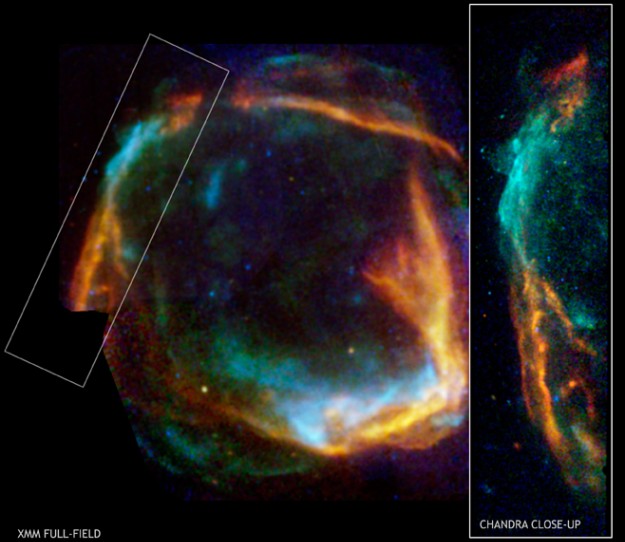
|
Explanation: In 185 AD, Chinese astronomers recorded the appearance of a new star in the Nanmen asterism - a part of the sky identified with Alpha and Beta Centauri on modern star charts. The new star was visible for months and is thought to be the earliest recorded supernova. Data from two orbiting X-ray telescopes of the 21st century, XMM-Newton and Chandra, now offer evidence that supernova remnant RCW 86 is indeed the debris from that stellar explosion. Their composite, false-color view of RCW 86 shows the expanding shell of material glowing in x-rays with high, medium, and low energies shown in blue, green, and red hues. Shock velocities measured in the x-ray emitting shell and an estimated radius of about 50 light-years can be used to find the apparent age of the remnant. The results indicate that light from the initial explosion could well have first reached planet Earth in 185 AD. Near the plane of our Milky Way Galaxy, RCW 86 is about 8,200 light-years away.
|
January February March April May June July August September October November December |
| ||||||||||||||||||||||||||||||||||||||||||||||||
NASA Web Site Statements, Warnings, and Disclaimers
NASA Official: Jay Norris. Specific rights apply.
A service of: LHEA at NASA / GSFC
& Michigan Tech. U.
Based on Astronomy Picture
Of the Day
Publications with keywords: supernova - supernova remnant - SN 185
Publications with words: supernova - supernova remnant - SN 185
See also:
- APOD: 2025 October 1 Á NGC 6960: The Witchs Broom Nebula
- APOD: 2025 July 31 Á Supernova 2025rbs in NGC 7331
- APOD: 2025 June 9 Á Between Scylla and Charybdis: A Double Cosmic Discovery
- Supernova Remnant Cassiopeia A
- APOD: 2025 January 8 Á Supernova Remnants Big and Small
- APOD: 2024 September 18 Á The Mermaid Nebula Supernova Remnant
- APOD: 2024 April 16 Á Filaments of the Vela Supernova Remnant
